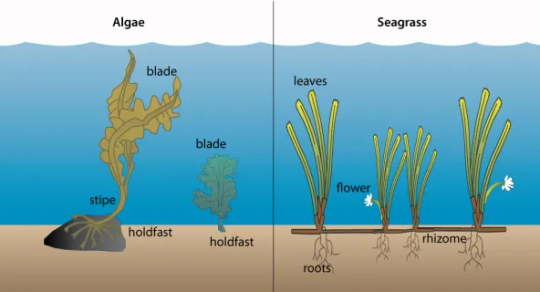#seagrassisnotagrass
Explore tagged Tumblr posts
Text
The Secret Gems of the Sea Floor
Hello everyone! I hope you had a relaxing weekend because I know I did hehe. We're nearing the end of Francology with the next entry being the last but fret not, I would still share my other thoughts from time to time beyond the pinned scope ^_^.
Alright, this week's topic is on Seagrass™. You wanna know something funny about them? They're actually not a type of grass but instead, it's more of a lily.

Right?! It's like coral reefs being animals all over again.
That being said:
What are seagrasses?
Seagrasses are angiosperms, meaning they are flowering plants and are found all around the world, in both hot and cold locations. They originally lived on land but adapted to living in water millions of years ago. They have specialised leaves where they exchange oxygen and carbon dioxide with the seawater through small holes called pit bumps. Unlike plants on land, seagrasses don't get oxygen from the soil but instead, they get it through their thin leaves. The roots of seagrasses also help keep sediment in place (Cullen-Unsworth et al. 2018a).

In many spots, seagrass plants cover big areas on the seafloor, and we call these spots "seagrass beds" or "seagrass meadows." These meadows are usually in shallow, sheltered areas. Just like the plants with flowers on land, seagrasses also have flowers, fruits, and seeds. But instead of relying on insects and the wind for things like pollination and seed travel, seagrasses get help from marine creatures and the movement of water. There are tiny critters called crustaceans, kind of like really small shrimp, that are sometimes called the "bees of the sea" because they help pollinate seagrass flowers, just like bees do for plants on land (Cullen-Unsworth et al. 2018a).
Why are seagrasses important?
Seagrass is like a bustling underwater neighborhood for thousands of sea creatures (Reynolds 2018). It's where more than 1,000 different types of fish hang out, including ones we love to eat like cod and herring, as well as bigger endangered animals like seahorses, dugongs, turtles, seahorses, and manatees (those cool sea cows). These meadows are not only great for fish but also support coral reefs and other fish habitats by providing food and a safe spot for baby fish to chill. Seagrasses are known as the primary food producers because they whip up their own grub through photosynthesis and then become dinner for other animals. So, they play a crucial role in the underwater food chain.
Seagrass is also the glue that holds the underwater soil (called sediment) in place, which is like a shield that protects our coasts from getting battered by storms and big waves, stopping the land from washing away.
But here's the coolest part: Seagrass is like a superhero fighting climate change. Just like regular plants take in carbon dioxide from the air, seagrasses slurp up carbon dioxide that's dissolved in the seawater. They use this carbon dioxide to grow or stash it in the sediment. Experts say seagrass meadows can trap carbon in underwater dirt a whopping 40 times faster than tropical forests do in the soil (Fourqurean et al. 2012). This is a big deal because it helps keep the water's pH level stable, which is a measure of how acidic or basic it is. A stable pH is good news for animals with shells or tough outer coverings, like corals and shellfish (think clams and oysters), as it shields them from ocean acidification.
All the ways that seagrass helps out us humans are called "ecosystem services," and these services make seagrass one of the most vital marine ecosystems for our well-being.
Threats to seagrass and what can be done to help
Despite how crucial they are, seagrass meadows worldwide are disappearing pretty fast, at a rate of about 7% every year (Waycott et al. 2009). This loss is often connected to things like building new stuff along the coast, pollution from rivers and streams flowing into the sea, and overfishing.
If we want seagrass to withstand bigger and longer-lasting challenges like climate change, we've got to do some things on the local level. That means improving the quality of the water nearby, making sure we don't mess up seagrass meadows, setting up safe zones for seagrass, cutting back on overfishing, and not letting coastal development stress them out (Cullen-Unsworth and Unsworth 2016b). When we protect seagrass, we're not just looking out for the cool life living there, but we're also doing our part to fight climate change and making sure people have enough to eat from the sea. It might take some big moves to protect and bring back these spots, but if lots of folks take small steps to look out for seagrass, we can give these hidden underwater gardens a brighter future.

References:
Cullen-Unsworth, LC, Jones, BL, Lilley, R and Unsworth, RKF 2018, Secret gardens under the sea: what are seagrass meadows and why are they important?, Frontiers, viewed 17 October 2023, <https://kids.frontiersin.org/articles/10.3389/frym.2018.00002#ref2>.
Cullen-Unsworth, LC and Unsworth, RKF 2016b, 'Strategies to enhance the resilience of the world's seagrass meadows' Journal of Applied Ecology, vol. 53, no. 4, pp. 1 - 6.
Fourqurean, JW, Duarte, CM, Kennedy, H, Marba, N, Holmer, M, Mateo, MA, Apostolaki, ET, Kendrick, GA, Krause-Jensen, D, McGlathery, KJ and Serrano, O 2012, 'Seagrass ecosystems as a globally significant carbon stock', Nature Geoscience, no. 5, pp. 505 - 509.
Reynolds, PL 2018, Seagrass and seagrass beds, Smithsonian, viewed 17 October 2023, <https://ocean.si.edu/ocean-life/plants-algae/seagrass-and-seagrass-beds>.
Waycott, M, Duarte, CM, Carruthers, TJB and Orth, RJ 2009, 'Accelerating loss of seagrass across the globe threatens coastal ecosystems', Proceedings of the National Academy of Sciences, vol. 106, no. 30, pp. 12377 - 12381.
26 notes
·
View notes